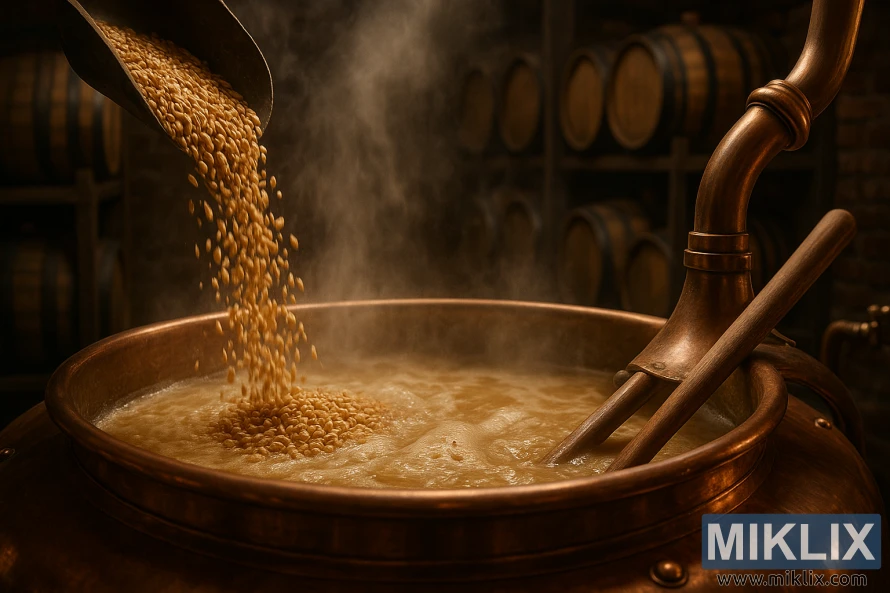Image: Brewing with wheat malt in kettle
Published: July 23, 2025 at 6:29:15 AM UTC
Last updated: September 27, 2025 at 3:48:23 PM UTC
In a cozy brewhouse, golden wheat malt is poured into a copper kettle as steam rises and mash paddles stir, with oak barrels in the background evoking craft.
In the heart of a traditional brewhouse, the scene glows with the warmth of craftsmanship and the quiet rhythm of a time-honored process. The focal point is a gleaming copper brew kettle, its polished surface reflecting the ambient light in soft, golden tones. Steam rises steadily from its wide mouth, curling into the air and casting a gentle haze that blurs the edges of the room, creating an atmosphere that feels both intimate and industrious. The kettle is alive with motion—a mechanical arm stirs the frothy liquid within, revealing the creamy texture of the wort as it begins to take shape. This is the mashing stage, where water and malted grain meet in a transformative embrace, unlocking sugars and setting the foundation for flavor.
A scoop pours a steady stream of wheat malt kernels into the kettle, their golden hues catching the light as they fall. Each kernel is a small promise of depth and character, chosen for its subtle sweetness and smooth mouthfeel. The grains tumble in with a soft rustle, disappearing into the swirling mixture below. The process is both mechanical and organic, a blend of precision and intuition. The mash paddles churn slowly, ensuring even distribution and consistent temperature, coaxing out the essence of the malt with deliberate care.
Surrounding the kettle, the brewhouse reveals its layered textures and quiet details. Wooden barrels line the shelves in the background, their curved staves darkened with age and use. Some are stacked horizontally, others upright, each one a vessel of potential, waiting to impart its own character to the brew. The barrels suggest a future stage in the process—aging, conditioning, perhaps even experimentation with oak or spirit-infused finishes. Their presence adds depth to the narrative, hinting at the complexity and patience that define the final product.
The lighting throughout the space is warm and diffused, casting long shadows and highlighting the natural materials that make up the brewhouse. Copper, wood, and grain dominate the palette, creating a visual harmony that mirrors the balance sought in the brewing process. The air is thick with aroma: the nutty scent of malted wheat, the earthy undertones of steam and grain, and the faint whisper of oak from the barrels nearby. It’s a sensory experience that envelops the room, grounding the viewer in the moment and inviting them to linger.
This image captures more than a brewing step—it encapsulates a philosophy. It speaks to the quiet focus of the brewer, the respect for ingredients, and the deliberate pace of artisanal production. The wheat malt, central to the composition and the recipe, is treated not as a commodity but as a collaborator, its qualities carefully coaxed into the wort with attention and care. The copper kettle, the steam, the barrels, and the grains all contribute to a narrative of transformation, where raw materials become something greater through skill, time, and intention.
In this cozy, amber-lit brewhouse, the act of brewing is elevated to ritual. It is a space where tradition meets innovation, where each batch is a reflection of the brewer’s choices and the environment’s influence. The image invites the viewer to imagine the next steps—the boil, the fermentation, the pour—and to appreciate the quiet beauty of a process that has endured for centuries, still unfolding with grace and purpose in every kettle of wort.
The image is related to: Brewing Beer with Wheat Malt

